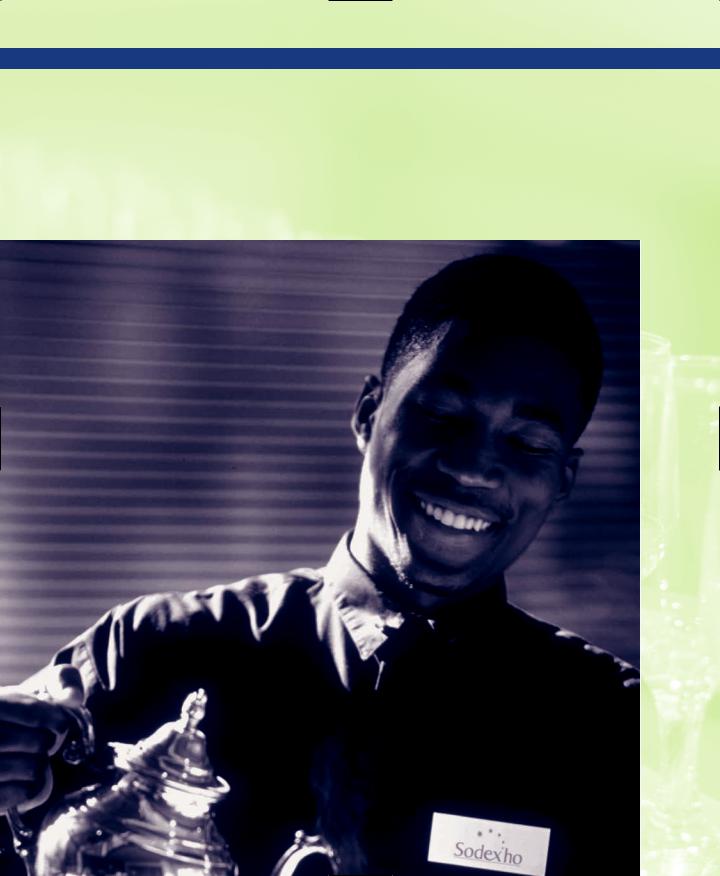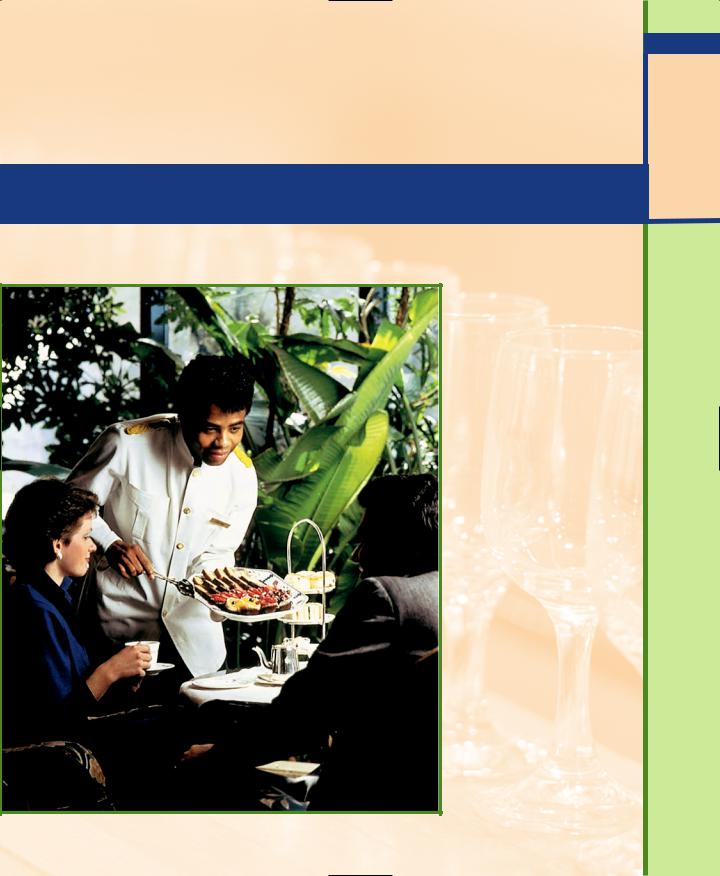
- •CONTENTS
- •PREFACE
- •Content—Benefits for Students
- •Content—Benefits for Instructors
- •Features of the Book for Students and Instructors
- •Supplementary Materials
- •Acknowledgments
- •What Is Hospitality Management?
- •The Manager’s Role in the Hospitality Industry
- •Why Study in a Hospitality Management Program?
- •Planning a Career
- •Employment as an Important Part of Your Education
- •Getting a Job
- •Employment at Graduation
- •The Outlook for Hospitality
- •Summary
- •Managing Change
- •Demand
- •Supply
- •Workforce Diversity
- •The Impact of Labor Scarcity
- •Summary
- •The Varied Field of Food Service
- •The Restaurant Business
- •The Dining Market and the Eating Market
- •Contemporary Popular-Priced Restaurants
- •Restaurants as Part of a Larger Business
- •Summary
- •Restaurant Operations
- •Making a Profit in Food Service Operations
- •Life in the Restaurant Business
- •Summary
- •Chain Restaurant Systems
- •Independent Restaurants
- •Franchised Restaurants
- •Summary
- •Competitive Conditions in Food Service
- •The Marketing Mix
- •Competition with Other Industries
- •Summary
- •Self-Operated Facilities
- •Managed-Services Companies
- •Business and Industry Food Service
- •College and University Food Service
- •Health Care Food Service
- •School and Community Food Service
- •Other Segments
- •Vending
- •Summary
- •Consumer Concerns
- •Food Service and the Environment
- •Technology
- •Summary
- •The Evolution of Lodging
- •Classifications of Hotel Properties
- •Types of Travelers
- •Anticipating Guest Needs in Providing Hospitality Service
- •Service, Service, Service
- •Summary
- •Major Functional Departments
- •The Rooms Side of the House
- •Hotel Food and Beverage Operations
- •Staff and Support Departments
- •Income and Expense Patterns and Control
- •Entry Ports and Careers
- •Summary
- •The Economics of the Hotel Business
- •Dimensions of the Hotel Investment Decision
- •Summary
- •The Conditions of Competition
- •The Marketing Mix in Lodging
- •Product in a Segmented Market
- •Price and Pricing Tactics
- •Place—and Places
- •Promotion: Marketing Communication
- •Summary
- •The Importance of Tourism
- •Travel Trends
- •The Economic Significance of Tourism
- •The United States as an International Tourist Attraction
- •Businesses Serving the Traveler
- •Noneconomic Effects of Tourism
- •Summary
- •Motives and Destinations
- •Mass-Market Tourism
- •Planned Play Environments
- •Casinos and Gaming
- •Urban Entertainment Centers
- •Temporary Attractions: Fairs and Festivals
- •Natural Environments
- •On a Lighter Note. . .
- •Summary
- •Management and Supervision
- •The Economizing Society
- •The Managerial Revolution
- •Management: A Dynamic Force in a Changing Industry
- •What Is Management?
- •Summary
- •Why Study Planning?
- •Planning in Organizations
- •Goal Setting
- •Planning in Operations
- •The Individual Worker as Planner
- •Long-Range Planning Tools
- •Summary
- •Authority: The Cement of Organizations
- •Departmentalization
- •Line and Staff
- •Issues in Organizing
- •Summary
- •Issues in Human-Resources Management
- •Fitting People to Jobs
- •Recruiting
- •Selection and Employment
- •Training
- •Retaining Employees
- •Staff Planning
- •Summary
- •The Importance of Control
- •Control and the “Cybernetic Loop”
- •Tools for Control
- •Summary
- •Leadership as Viewed by Social Scientists
- •Why People Follow
- •Leadership Theories
- •Communication
- •The Elements of Leading and Directing
- •Developing Your Own Leadership Style
- •Summary
- •A Study of Service
- •Rendering Personal Service
- •Managing the Service Transaction
- •How Companies Organize for Service
- •Summary
- •INDEX

Developing Your Own Leadership Style |
639 |
were getting better and enabled them to respond to comments about worn facilities positively. “We’re working on it. It’s going to get better” is a more effective response— to both employee and guest—than “Gee, I’m sorry it’s such a mess.”
Aligning People. Bill’s frequent attendance at department meetings and his almost daily meetings with department heads in the early days established a new attitude— that somebody cared about the property. The consistent, realizable vision of improving service was repeated in every conversation and sold people on the idea that the hotel could be turned around. People either left the organization or began to take responsibility for their actions with the guests. Significantly, Bill had to sell his boss and the corporate headquarters on every investment in the property. From the beginning, he took a serious career risk in refusing to continue without support. In the longer run, he used effective operating results to line up support both above and below for his vision of returning the hotel to first-class status.
Motivating and Inspiring. Effective employees were recognized. Virtually all supervisory positions were filled by promotions from within. Effective performance was rewarded with public and highly visible praise, and effective people found their salaries raised as much as company policy permitted. These actions supported the growing enthusiasm for the turnaround program.
In a time of crisis, when change is needed, leadership becomes especially crucial. Good solid management needs to accompany leadership, but leadership has to tell managers where they are going (direction), line up support for new direction (alignment), and keep everybody sold and enthusiastic (motivating and inspiring). All of these are important in everyday leadership, too, but especially so in a time when an organization needs dramatic change.
Industry Practice Note 20.1 looks more specifically at real-life leaders in the hospitality industry.
Developing Your Own Leadership Style
As we have argued earlier, a manager’s leadership role in directing the work ultimately stems from his or her formal authority. To direct work effectively, managers must take into account at least three factors. The first is the work that needs to be done. The second is the person or persons who are to do the work—and their individual characteristics. The third is the informal socializing group structure of the
work group in question.
In fact, then, leadership is not an inflexible behavior pattern. Leadership styles will vary from situation to situation and place to place. If you are a junior manager just out

INDUSTRY PRACTICE NOTE 20.1
Leadership in the Hospitality Industry
As we have discussed in this chapter, leadership has received a lot of attention over the years and continues to capture the attention of researchers and industry practitioners. Universities, which have taught the subject for years, have developed leadership courses, leadership programs, and even degrees in leadership. However leadership is defined, one thing is clear: It is an important characteristic of those who are in influential positions in a variety of fields, including the public sector, politics, the military, the private sector, religion, and the hospitality industry.
When the term “leader” is used, several names should immediately come to the minds of hospitality students: Bill Marriott, Norman Brinker, Herb Kelleher, Jan Carlzon, and Walt Disney, among others. These individuals have all led multimillion-dollar hospitality organizations, overseeing tens of thousands of employees, and most, if not all, have written books about their experiences. Further, it should come as no surprise that each of their respective organizations is associated with a strong culture—something that leaders help to form and maintain. To quote one scholar on the relationship between leadership and culture, “Leaders who appreciate the importance of culture spend more time communicating values than they do anything else. . . . They put values into action by treating employees as they want employees to treat their customers.”1
Culture, vision, and change all figure prominently in current discussions of effective leaders.2
So, leaders appreciate the importance of corporate culture, encourage specific workplace values, and are highly visible, both within the organization and without. But what else do they stand for and what are the other characteristics that make them what they are? Various authors and researchers have suggested that leaders have a vision; share that vision with the entire organization; are committed to organizational learning; are able to recognize, capture, and reward competence; and have the power of influence. They are described by both their personality traits and their behaviors. They are risk takers. They have led their companies through difficult times. They have been successful. They deal effectively with change. They inspire people within the organization. They accomplish goals. In short, while the definitions of leadership, and how to characterize leaders, will continue to be debated over time, most agree that one knows a leader when one sees one. The hospitality industry has been fortunate to have the leaders that it has had, as they serve as good role models for future leaders in the industry.
1.Robert Ford and Cherrill Heaton, “Lessons from Hospitality that Can Serve Anyone,” Organizational Dynamics, Summer, 2002, p. 39.
2.Kenneth Greger and John Peterson, “Leadership Profiles for a New Millennium,” The Cornell Hotel and Restaurant Administration Quarterly, February 2000.
of training and working with a group of senior workers, you will conduct yourself more tentatively than you might later as a general manager dealing with a similar group. If your employees’ work is exciting and highly profitable, as might be the case for a server group in a topflight restaurant yielding generous tips, your leadership conduct might be different from what it would be toward the night cleanup crew that arrives as the restaurant is closing.
640

Developing Your Own Leadership Style |
641 |
CAREERS IN HOSPITALITYQ
The dictionary provides several meanings for the word style. One of the meanings is a synonym for fashion—the way “everybody” is doing something. When we speak of management style, however, we certainly do not mean the current fashion. The definition that suits our needs better is “the manner or tone assumed in a discussion.” The way leadership is carried out reflects the person who does the leading. Some leaders are flamboyant and confident; others, more reserved and (at least at first) unsure. The important point is that leadership in our industry is not some mysterious thing one is born with or without. Rather, it is a set of learned abilities. Just as people’s personalities differ, so each person is likely to behave differently in directing the work of others. The difference, however, is usually in style, in manner and tone, not in substance. The basic goal of directing, as in all management functions, is achieving the desired results.
It will be up to you, finally, to determine how you best achieve results. Your success, however, will depend not only on the strength of your formal position, on the workers and work you direct, and on the work group, but also on who you are and what manner and tone, what style, works best for you in the situations you face.
You can begin to form your leadership style now, and you should. In field experiences, summer jobs, and part-time employment, you can observe the management style of others, even though you may not at first be given managerial responsibility. You can analyze the situations that managers confront and the people in those situations. Then you can decide for yourself how well you think the situations were handled, how they might have been handled better, and how you might feel most comfortable in handling similar situations.
In preparing for your future as a leader, keep in mind some of the research findings from recent studies:
■Leadership capacity of companies is on the decline.
■Companies do not seem to be doing what is necessary to develop replacements for current leaders.
■The emphasis in organizations is likely to become more focused on leadership rather than technical skills.
■Leaders of the next decade will need to be master strategists, change managers, relationship builders, and talent developers.7
You should certainly consider the process of learning to act as a leader and directing the work of others as continuous and lifelong. The most accomplished artists, after years of practice, will still speak of how much they have left to learn. Management, as it is implemented by individual managers, is definitely an art based on understanding and practice. It is a fascinating art one can learn through both study and practice. The fascination can last a lifetime, and the process has already begun for you.

642 |
Chapter 20 Leadership and Directing in Hospitality Management |
Summary
First, we defined leadership, differentiated it from direction, and explained the reasons that it is important.
Our second subject was people’s motivations for working: necessity; advantage; personal satisfaction; independence; encouragement, praise, and recognition; money; and company policy. This led us to consider whether happiness, or high morale, results in high productivity.
We discussed MacGregor’s Theory X and Theory Y, plus three elements of modern leadership: authority, psychology of the worker, and the work group. Worker participation was also described as important.
Good communication between managers and workers is important as well, and so we talked about possible barriers (semantic, social background, and immediate environment) and possible gateways (listening and empathy) to effective communication.
The last topics were an enumeration and description of the elements of leading and directing, the special requirements of leadership in times of crisis, and ways to develop your own leadership style.
Key Words and Concepts
Leadership |
Theory X |
Directing |
Theory Y |
Motivation |
Work group |
Fringe benefits |
Formal leader |
Working conditions |
Informal leader |
Morale |
Cliques |
Leadership styles |
|
Review Questions
1.What is the difference between leadership and direction?
2.Describe what might happen in a quick-service restaurant without leadership.
3.List and briefly discuss the motivations for working.
4.How do Theory X and Theory Y fit with your management style—or intended style? Would you lean toward X, Y, or some other position?

Summary 643
5.Using the three basic elements of leadership discussed in this chapter, analyze a critical situation you have encountered, either at work or as a student. How did the leaders involved respond? How should they have responded? What would you have done?
6.Describe the informal structure of a work group to which you have belonged.
7.Describe a manager or boss you have admired, and explain why.
8.Do you think you would be a good leader? Why or why not?
Internet Exercises
1.Site name: Hotel, Restaurant and Tourism Online Professional and Trade Journals
URL: www.wku.edu/,hrtm/journal.htm
Background information: This Web page provides links to hospitality professional and
trade journals online and serves as a launch pad to retrieve information from these journals. Some journal sites require a free registration in order to access their materials.
Exercises: Choose several of the online journals and search for recent articles on employee motivation, work motivation, productivity, leadership, facilitating change, or any topic deemed appropriate by the instructor. Read the articles and lead a class discussion on the topic you have chosen. How do the articles supplement the information in the textbook? Be sure to provide the other students with the names and Web address of the journals where the information was found.
2.Site name: The Center for Public Leadership
URL: www.ksg.harvard.edu/leadership
Background information: The center is dedicated to excellence in leadership educa-
tion and research. It is equally committed to bridging the gap between leadership theory and practice. It provides a forum for students, scholars, and practitioners committed to the idea that effective public leadership is essential to the common good.
The Leader to Leader Institute
URL: www.pfdf.org
Background information: The Leader to Leader Institute has its roots in the social sector and its predecessor, the Peter F. Drucker Foundation for Nonprofit Management. Its mission is “to strengthen the leadership of the social sector” by providing educational opportunities and resources to leaders.
CIO (Chief Information Officer)
URL: www.cio.com/research/leadership

644 |
Chapter 20 Leadership and Directing in Hospitality Management |
Background information: CIO and CIO.com are published by CXO Media Inc. to meet the needs of CIOs (chief information officers) and other information executives.
CIO is read by more than 140,000 CIOs and senior executives who oversee annual IT budgets in excess of $175 million.
Exercises: Choose an article or research study from one of the Web sites above and discuss how the concepts in the article might help you fulfill a leadership role in the hospitality industry. Your discussion should include the following, as applicable:
a.What behaviors does this article suggest will help you to become a more effective leader?
b.Does this article suggest ways for managers to make decisions differently? If so, how?
c.Does this article influence the way you will communicate with people in the future? If so, how?
d.Does this article address the three elements of modern leadership as described in the textbook? If so, which elements and how does it address these elements?
e.Does this article address ways in which a leader can facilitate change in an organization? If so, how?
f.Does this article help you to develop your own leadership style? Why or why not?
Notes
1.Kenneth Greger and John Peterson, “Leadership Profiles for a New Millennium,” The Cornell Hotel and Restaurant Administration Quarterly, February 2000.
2.Douglas MacGregor, The Human Side of Enterprise (New York: McGraw-Hill, 1960).
3.An excellent discussion of this subject is found in George C. Homans, The Human Group (New York: Harcourt Brace and World, 1950).
4.Conference Board of Canada, June 2006.
5.John P. Kotter, A Force for Change (New York: The Free Press, 1990).
6.This incident is adapted from a case provided by the executive described and is chronicled in more detail there. See Thomas F. Powers, The Royal Hotel (Guelph, Ontario: School of Hospitality and Tourism Management).
7.Developing Business Leaders for 2010, Conference Board of Canada, April, 2002, p. 6.

P A R T S I X
Hospitality as a
Service Industry

The Hospitality Industry
(Courtesy of Four Seasons Hotels.)

C H A PCTHEARP T WERE NOTNYE- O N E
TheTheRoleHospitalityof Service
Iindustrythe Hospitalityand You
Industry
The Purpose of this Chapter
hile details differ, the tangible side of the hospitality industry, within segments, is surpris-
Wingly similar. Quick-service operations resemble one another within food categories, one budget motel offers pretty much the same as another, and so forth. Whether it’s Big Mac versus the Whopper or Hampton Inns versus Fairfield Inns, company offerings look a lot alike.
Increasingly, companies are realizing that service is the best way to achieve differentiation and is what can give an operation a competitive edge. This chapter examines service as a process, considers the work of rendering service as a personal experience, and, finally, considers how companies manage service.
THIS CHAPTER SHOULD HELP YOU
1.Define service in terms of both guest experience and the operation’s performance.
2.Describe the principal characteristics of service, and contrast it to delivery of a physical product.
3.Describe what is necessary to successfully fulfill both the task and the interpersonal requirements of service.
4.Identify and describe the two basic approaches to managing the service process.
5.Explain how market segmentation forms the basis for a service strategy, and identify the requirements for establishing a strong service culture.
6.Describe the importance of service as a basis for successful competition in the hospitality industry.
